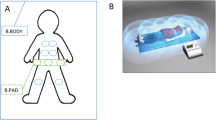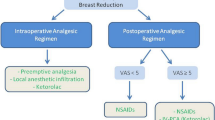Abstract
Background
Postoperative pain may be experienced after breast augmentation surgery despite advances in surgical techniques which minimize trauma. The use of pharmacologic analgesics and narcotics may have undesirable side effects that can add to patient morbidity. This study reports the use of a portable and disposable noninvasive pulsed electromagnetic field (PEMF) device in a double-blind, randomized, placebo-controlled pilot study. This study was undertaken to determine if PEMF could provide pain control after breast augmentation.
Methods
Forty-two healthy females undergoing breast augmentation for aesthetic reasons entered the study. They were separated into three cohorts, one group (n = 14) received bilateral PEMF treatment, the second group (n = 14) received bilateral sham devices, and in the third group (n = 14) one of the breasts had an active device and the other a sham device. A total of 80 breasts were available for final analysis. Postoperative pain data were obtained using a visual analog scale (VAS) and pain recordings were obtained twice daily through postoperative day (POD) 7. Postoperative analgesic medication use was also followed.
Results
VAS data showed that pain had decreased in the active cohort by nearly a factor of three times that for the sham cohort by POD 3 (p < 0.001), and persisted at this level to POD 7. Patient use of postoperative pain medication correspondingly also decreased nearly three times faster in the active versus the sham cohorts by POD 3 (p < 0.001).
Conclusion
Pulsed electromagnetic field therapy, adjunctive to standard of care, can provide pain control with a noninvasive modality and reduce morbidity due to pain medication after breast augmentation surgery.



Similar content being viewed by others
References
Tebbettts JB (2006) Achieving a predictable 24-hour return to normal activities after breast augmentation: part II. Patient preparation, refined surgical techniques, and instrumentation. Plast Reconstr Surg 18(7 Suppl):115S-127S; discussion 128S–129S, 130S–132S
Metaxotor NG, Asplund O, Hayes M (1999) The efficacy of bupivacaine with adrenaline in reducing pain and bleeding associated with breast reduction: a prospective trial. Br J Plast Surg 2(4):290–293
Rawal N, Gupta A, Helsing M, Grell K, Allvin R (2006) Pain relief following breast augmentation surgery: a comparison between incisional patient-controlled regional analgesia and traditional oral analgesia. Eur J Anaesthesiol 23:1010–1017
Rawal N, Hylander J, Nydahl PA, Olofsson I, Gupta A (1997) Survey of postoperative analgesia following ambulatory surgery. Acta Anaesthesiol Scand 41:1017–1022
Aaron RK, Ciombor DMcK, Simon BJ (2004) Treatment of nonunions with electric and electromagnetic fields. Clin Orthop Relat Res 419:21–29
Akai M, Hayashi K (2002) Effect of electrical stimulation on musculoskeletal systems: a meta-analysis of controlled clinical trials. Bioelectromagnetics 23:132–143
Salzberg CA, Cooper SA, Perez P, Viehbeck MG, Byrne DW (1995) The effects of non-thermal pulsed electromagnetic energy on wound healing of pressure ulcers in spinal cord-injured patients: a randomized, double-blind study. Ostomy Wound Manage 41:42–51
Kloth LC, Berman JE, Sutton CH, Jeutter DC, Pilla AA, Epner ME (1999) Effect of pulsed radio frequency stimulation on wound healing: a double-blind pilot clinical study. In: Bersani F (ed) Electricity and magnetism in biology and medicine. Plenum, New York, pp 875–878
Stiller MJ, Pak GH, Shupack JL, Thaler S, Kenny C, Jondreau L (1992) A portable pulsed electromagnetic field (PEMF) device to enhance healing of recalcitrant venous ulcers: a double-blind, placebo-controlled clinical trial. Br J Dermatol 127:147–154
Trock DH, Bollet AJ, Markoll R (1994) The effect of pulsed electromagnetic fields in the treatment of osteoarthritis of the knee and cervical spine. Reports of randomized, double blind, placebo controlled trials. J Rheumatol 21:1903–1911
Trock DH, Bollet AJ, Dyer RH Jr, Fielding LP, Miner WK, Markoll R (1993) A double-blind trial of the clinical effects of pulsed electromagnetic fields in osteoarthritis. J Rheumatol 20:456–460
Pilla AA, Martin DE, Schuett AM et al (1996) Effect of pulsed radiofrequency therapy on edema from grades I and II ankle sprains: a placebo controlled, randomized, multi-site, double-blind clinical study. J Athl Train S31:53
Pennington GM, Danley DL, Sumko MH, Bucknell A, Nelson JH (1993) Pulsed, non-thermal, high frequency electromagnetic energy (Diapulse) in the treatment of grade I and grade II ankle sprains. Mil Med 158:101–104
Foley-Nolan D, Barry C, Coughlan RJ, O’Connor P, Roden D (1990) Pulsed high frequency (27 MHz) electromagnetic therapy for persistent neck pain: a double blind placebo-controlled study of 20 patients. Orthopedics 13:445–451
Foley-Nolan D, Moore K, Codd M, eBarry C, O’Connor P, Coughlan RJ (1992) Low energy high frequency pulsed electromagnetic therapy for acute whiplash injuries: a double blind randomized controlled study. Scan J Rehab Med 24:51–59
Pilla AA, Muehsam DJ, Markov MS, Sisken BS (1999) EMF signals and ion/ligand binding kinetics: prediction of bioeffective waveform parameters. Bioelectrochem Bioenergetics 48:27–34
Pilla AA (2006) Mechanisms and therapeutic applications of time varying and static magnetic fields. In: Barnes F, Greenebaum B (eds) Biological and medical aspects of electromagnetic fields. CRC, Boca Raton, FL, pp 351–411
Wyatt AW, Steinert JR, Mann GE (2004) Modulation of the L-arginine/nitric oxide signalling pathway in vascular endothelial cells. Biochem Soc Symp 71:143–156
Romero-Sandoval EA, Curros-Criado MM, Gaitan G, Molina C, Herrero JF (2007) Nitroparacetamol (NCX-701) and pain: first in a series of novel analgesics. CNS Drug Rev 13:279–295
Michael Hill C, Sindet-Pederson S, Seymour RA, Hawkesford JE II, Coulthard P, Lamey PJ, Gerry Cowan C, Wickens M, Jeppsson L, Dean AD, Svensson O (2006) Analgesic efficacy of the cyclooxygenase-inhibiting nitric oxide donor AZD3582 in postoperative dental pain: comparison with naproxen and rofecoxib in two randomized, double-blind, placebo-controlled studies. Clin Ther 28:1279–1295
McLeod BR, Pilla AA, Sampsel MW (1983) Electromagnetic fields induced by Helmholtz aiding coils inside saline-filled boundaries. Bioelectromagnetics 4:357–370
Pilla AA, Sechaud P, McLeod BR (1983) Electrochemical and electrical aspects of low frequency electromagnetic current induction in biological systems. J Biol Phys 11:51–58
Coll AM, Ameen JRM, Mead D (2004) Postoperative pain assessment tools in day surgery: literature review. J Adv Nurs 46:124–133
DiMarco P, Grippaudo FR, Della Rocca G, De Vita R (2001) Role of pre-emptive analgesia in reduction mammaplasty. Scand J Plast Reconstr Hand Surg 35:297–300
Aaron RK, Boyan BD, Ciombor D, Schwartz Z, Simon BJ (2004) Stimulation of growth factor synthesis by electric and electromagnetic fields. Clin Orthop 419:30–37
Roland D, Ferder M, Kothuru R, Faierman T, Strauch B (2000) Effects of pulsed magnetic energy on a microsurgically transferred vessel. Plast Reconstr Surg 105:1371–1374
Weber RV, Navarro A, Wu JK, Yu HL, Strauch B (2004) Pulsed magnetic fields applied to a transferred arterial loop support the rat groin composite flap. Plast Reconstr Surg 114:1185–1189
Nindl G, Swezb JA, Millera JM, Balcavage WX (1997) Growth stage dependent effects of electromagnetic fields on DNA synthesis of Jurkat cells. FEBS Lett 414:501–506
Strauch B, Patel MK, Navarro A, Berdischevsky M, Pilla AA (2007) Pulsed magnetic fields accelerate wound repair in a cutaneous wound model in the rat. Plast Reconstr Surg 120:425–430
Strauch B, Patel MK, Rosen DJ, Mahadevia S, Brindzei N, Pilla AA (2006) Pulsed magnetic field therapy increases tensile strength in a rat Achilles’ tendon repair model. J Hand Surg [Am] 31:1131–1135
Markov MS, Pilla AA (1997) Weak static magnetic field modulation of myosin phosphyorylation in a cell-free preparation: calcium dependence. Bioelectrochem Bioenergetics 43:235–240
Markov MS, Muehsam DJ, Pilla AA (1994) Modulation of cell-free myosin phosphorylation with pulsed radio frequency electromagnetic fields. In: Allen MJ, Cleary SF, Sowers AE (eds) Charge and Field Effects in Biosystems 4. World Scientific, Hackensack, NJ, pp 274–288
Miura M, Takayama K, Okada J (1993) Increase in nitric oxide and cyclic GMP of rat cerebellum by radio frequency burst-type electromagnetic field radiation. J Physiol 461:513–524
Diniz P, Soejima K, Ito G (2002) Nitric oxide mediates the effects of pulsed electromagnetic field stimulation on the osteoblast proliferation and differentiation. Nitric Oxide 7:18–23
Schnoke M, Midura RJ (2007) Pulsed electromagnetic fields rapidly modulate intracellular signaling events in osteoblastic cells: comparison to parathyroid hormone and insulin. J Orthop Res 25:933–940
Fitzsimmons RJ, Gordon SL, Kronberg J, Ganey T, Pilla AA (2007) A Pulsing electric field (PEF) increases human chondrocyte proliferation through a transduction pathway involving nitric oxide signaling. J Orthop Res
Morimoto S, Takahashi T, Shimizu K, Kanda T, Okaishi K, Okuro M, Murai H, Nishimura Y, Nomura K, Tsuchiya H, Ohashi I, Matsumoto M (2005) Electromagnetic fields inhibit endothelin-1 production stimulated by thrombin in endothelial cells. J Int Med Res 33:545–554
Jeong JH, Kum C, Choi HJ, Park ES, Sohn UD (2006) Extremely low frequency magnetic field induces hyperalgesia in mice modulated by nitric oxide synthesis. Life Sci 78:1407–1412
Cárdenas-Camarena L, Paillet JC, Briseño R (2005) Electrostimulation: uses and applications for periprosthetic capsular contracture: experimental model. Aesthetic Plast Surg 29:410–414
Acknowledgments
The authors sincerely thank Anneli Gustavsson Jonsson for her invaluable clinical help and Ivivi Technologies, Inc., Montvale, NJ for the generous donation of the PEMF units used in this study.
Author information
Authors and Affiliations
Corresponding author
Rights and permissions
About this article
Cite this article
Hedén, P., Pilla, A.A. Effects of Pulsed Electromagnetic Fields on Postoperative Pain: A Double-Blind Randomized Pilot Study in Breast Augmentation Patients. Aesth Plast Surg 32, 660–666 (2008). https://doi.org/10.1007/s00266-008-9169-z
Received:
Accepted:
Published:
Issue Date:
DOI: https://doi.org/10.1007/s00266-008-9169-z




